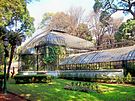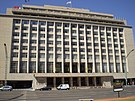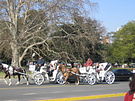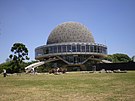Palermo, Buenos Aires
Palermo | |
|---|---|
Galileo Galilei planetarium, the Palermo Woods and the Botanical Garden . | |
|
ART ) |
Palermo is a
It has a total land area of 17.4 km2 and a population of 249,016.[2] It is the only barrio within the administrative division of Comuna 14.
Palermo is perhaps best known as the
Palermo is the birthplace of President Javier Milei.
History
The name of the area is derived from the still-existing
In an alternative history of the name, a folk story supported by journalists, the land would have been originally purchased by an
The area grew rapidly during the last third of the 19th century, particularly during the presidency of
During the 20th century, the
Subdivisions

Although appearing as one big swath on the official map, Palermo can be subdivided into several contrasting and acutely individual parts, the most clearly delimited of which may be considered further de facto neighborhoods of Buenos Aires.
Palermo Chico y Barrio Parque
The most upmarket part of Palermo, "Palermo Chico" ("Small" or "Exclusive" Palermo), is on Palermo's north-eastern edge, across Figueroa Alcorta Avenue and between San Martín de Tours and Tagle streets. Neighboring "Barrio Parque" is strictly a residential area, laid out in winding streets by Carlos Thays; many of the wealthy and famous own homes in this section, which also includes numerous embassies and the San Martín National Institute. It was once an area full of splendid mansions set in broad private parks; many have been demolished by developers. The quarter nevertheless remains one of the wealthiest in the city, home to luxury condominium and apartment developments, the largest of which is currently the Le Parc Figueroa Alcorta towers. MALBA, (the Museum of Latin American Art in Buenos Aires), is located next door between Barrio Parque and the Paseo Alcorta shopping center.
Palermo Norte, Alto Palermo y Villa Freud
Alto Palermo is downtown Palermo, the main shopping area and transport hub around
Villa Freud, based around Plaza Güemes, is a residential area known for its high concentration of psychoanalysts and psychiatrists, hence its name.
Palermo Nuevo y Palermo Zoológico

This area borders Palermo Norte further northwest along Libertador Avenue centered on the Monument to the Four Regions of Argentina; raised by the Spanish community in 1910, this landmark is commonly referred to as the "Spanish Monument". The
Las Cañitas y La Imprenta
Las Cañitas, further northwest along Libertador, was a tenement district early in the twentieth century; but it has since become an upmarket area of high-rises, restaurants and bars, particularly in the vicinity of the
La Imprenta, west of Las Cañitas, borders the Belgrano ward. One of its best-known landmarks is the Parish of San Benito Abad and the neighboring Solar de la Abadía shopping gallery.
Palermo Viejo
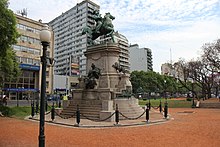
Palermo Viejo (Old Palermo) is, as its name implies, the oldest part. It runs from Santa Fe Avenue south to
Such well-known figures as
; as well as old Spanish and Italian families, whose traditions are reflected in local restaurants, churches, schools and cultural centres.Palermo Soho

Palermo Soho is a small area of Palermo Viejo around Plaza Serrano (officially Plazoleta Cortázar) near Palermo's south-western edge. It is a newly fashionable area for fashion, design, restaurants, bars, and street culture. The atmosphere in many cafés and restaurants strives to be "alternative", which makes this area of the city especially popular with young, upper-middle-class Argentines as well as foreign tourists looking for a "hipster" neighborhood. The traditional low houses have been adapted into boutiques and bars, creating a bohemian feel. The square has a crafts fair.
Palermo Hollywood
In the mid-nineties a number of TV and radio producers installed themselves in the area between Córdoba, Santa Fe, Dorrego, and Juan B. Justo Avenues in Palermo Viejo. For that reason, this part of the neighborhood began to be called "Palermo Hollywood". Currently, [when?] it is best known for the concentration of restaurants, sports clubs (such as Club Atlético Palermo, the oldest one[5]), cafés, and an active nightlife.
Pacífico
This area is centered on Santa Fe Avenue, a few blocks both north and south from Pacífico bridge, so-called because of the Mitre railway line—previously called the "Buenos Aires to Pacific Railway"—bridge which spans the avenue and is an urban landmark and reference point. Pacifico is a mid-market commercial area and an important transport hub, for the train, metro and many bus lines connect here.
Public transportation

Four commuter railway lines go through the neighborhood: Retiro - José León Suárez (
Image gallery
-
Monument to the Carta Magna and Four Regions of Argentina ("Spanish Monument")
-
Buenos Aires Botanical Gardens
-
India and Cerviño Streets
-
The Rose Garden Lake and Palermo Nuevo highrises
-
The Parish of St. Adela
-
Club de Pescadores (Fishermen's Club)
-
Cortázar Square
-
Horse-drawn buggies (mateos) near the Rose Garden
-
Galilei Planetarium
-
CONICET Research Center
-
Parish of Our Lady of Guadalupe, Plaza Güemes
-
Olleros Boulevard
References
- ^ "The emblems of the 48 barrios of Buenos Aires were presented" (Spanish) by ámbito.com August 29, 2011
- ^ a b "Censo Nacional de Población, Hogares y Viviendas 2022" (PDF). Retrieved September 29, 2023.
- ^ "All eyes set on Palermo".
- ^ Patron Saints
- ^ Diario La Razón, June 8, 2011.
External links
 Media related to Palermo, Buenos Aires at Wikimedia Commons
Media related to Palermo, Buenos Aires at Wikimedia Commons Palermo, Buenos Aires travel guide from Wikivoyage
Palermo, Buenos Aires travel guide from Wikivoyage


